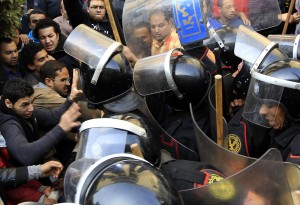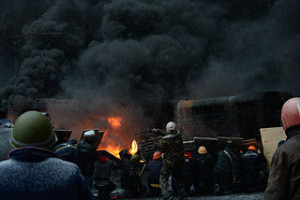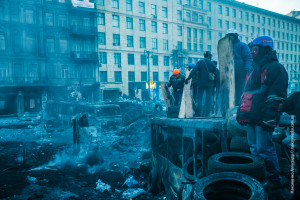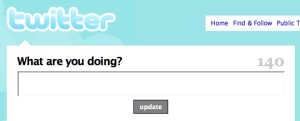Tweeting From The Barricades
 Civil unrest has reverberated around the world in recent years, from Moldavia in 2009, and the Arab Spring of early 2011 that shook the Middle East and plunged Syria into civil war, to the Occupy movement, and England’s smaller summer riots of the same year. The world is not a peaceful place, that shouldn’t be news to you, but in line with these several years of fluctuating, worldwide social unrest there has been a technological and digital revolution, changing the way people interact with others and the world around them. Social media has been interlaced and embedded in aspects of activism, protest, rioting and social revolution.
Civil unrest has reverberated around the world in recent years, from Moldavia in 2009, and the Arab Spring of early 2011 that shook the Middle East and plunged Syria into civil war, to the Occupy movement, and England’s smaller summer riots of the same year. The world is not a peaceful place, that shouldn’t be news to you, but in line with these several years of fluctuating, worldwide social unrest there has been a technological and digital revolution, changing the way people interact with others and the world around them. Social media has been interlaced and embedded in aspects of activism, protest, rioting and social revolution.
Twitter has been harnessed to spread awareness of governmental violence in the likes of Egypt, Iran and Syria, and to organise protests quickly and efficiently. So much so that the Iranian and Egyptian governments blocked the site in retaliation, with the Iranian regime in particular doing its utmost to censor both news media and internet communication.
During the summer riots in England, Twitter and Blackberry Messenger erupted with communication as news of the rioting spread and rioters started to organise themselves. The way in which social media was used in the London Riots naturally caused concern in the conservative press, claiming it aided criminality and the like. It can, obviously, be used negatively, but was also used after the riots to organise clean ups of the damage with hashtags such as #riotcleanup.

Social media, used through smartphone apps and laptops, has become a vital part of modern life for many people across the world, bringing international communication to a pinnacle point and it obviously changes the way we receive information, communicate and take part in the world around us. With the likes of Twitter and Facebook, people are kept abreast of world events as they unfold. People are more connected to the world than ever before, but there is still an issue with unreliable sources of information being passed around, re-tweeted, reblogged and shared as fact. Therein lay the limitations of social media; the difficulty in which some reports and claims cannot be easily verified. That being said, social media is very fluid, and while some incorrect information can be passed around, there are other instances where sources are debunked by witnesses.
Twitter has been used by news media outlets such as the BBC to release breaking news quickly and to a vast audience. It is, perhaps, one of the best ways to spread news across a world of mobile, interactive, online people. Yesterday, the battleground of Independence Square in Ukraine’s capital Kiev was again assaulted by police as they clashed with activists. Tweets from the BBC and other international reporters have kept the world abreast of the struggle. The BBC’s Gabriel Gatehouse tweeted “Protesters have taken back ground they lost. Both sides likely using live ammo. Quiet-ish at the moment. But unlikely police won’t respond.” Another stark tweet from a Russian journalist reported that armour piercing sniper fire was felling protesters “one after the other”, while Erin Alexis tweeted “Situation in #Ukraine horrifying. Reports of #doctors being shot by snipers as they care for the wounded. Terrible.”

This constant feed of grim updates comes from the very heart of Ukraine’s bitter struggle in Independence Square, and keeps people across the world updated as things are re-tweeted and discussed. Gatehouse later tweeted “8 dead bodies laid out on the street. Men, women crying. This country is in shock”, capturing the human impact of the violence. Of course, social media is open to abuse, in that false claims put out by people with strong agendas can soon garner attention and fan the flames of unrest whether they are accurate or not.
It is clear that social media has become engrained in the lives of millions, and that inevitably led to its utilisation in news reporting, activism, revolution and rioting. It provides real-time access to unfolding events, and Twitter in particular can act as a de facto emergency communication system for breaking news. It has been used in the search for missing people, and in 2013 Boston Police tweeted the news of the arrest of the Boston Marathon Bombing suspect.

The Crimean War of 1853-56 became the first “media” war when war correspondents harnessed the technological advances of telegram and photograph to send quicker, more current and critical reports that kept people back home abreast of day-to-day life in the Crimea. In a similar technological revolution, major modern news events are now often broken by people using social media, and reported on via the modern phenomenon of citizen journalism. Social media allows anybody with a smartphone and an internet connection to comment on and report on the events around them, often using photos and videos that give close, raw visuals to some of the world’s violent social unrest. As Kiev continues to be the sight of vicious fighting, and peace between the protesters and government seems to be getting more and more unlikely, reports will keep flooding onto social media to tell the world. They’ll come from reporters, activists and ordinary people who are quite literally tweeting from the barricades.


